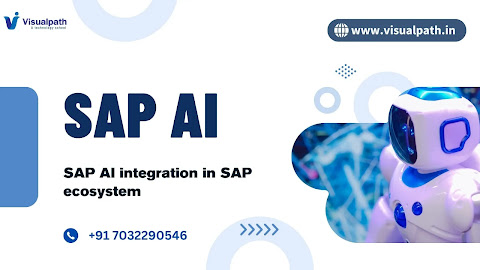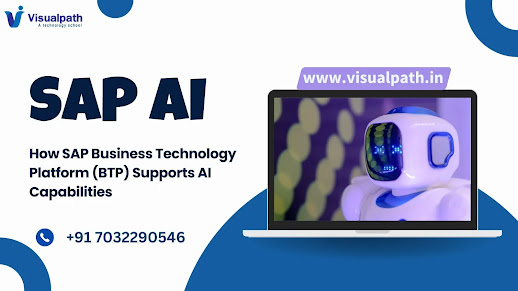The Main Components of SAP Cloud Platform Integration
The Main Components of SAP Cloud Platform Integration
SAP Cloud Platform Integration (SAP CPI) is a cloud-based integration
service from SAP that allows organizations to connect applications, systems,
and business processes seamlessly. It provides pre-built integration flows,
connectors, and advanced tools that reduce complexity and ensure faster
implementation. For learners and professionals exploring SAP CPI Training Online,
understanding the main components of CPI is the first step toward mastering
enterprise integration.
 |
| The Main Components of SAP Cloud Platform Integration |
Key Components of SAP Cloud Platform
Integration
To leverage SAP CPI effectively, you need to be familiar with its core
components. Each component plays a critical role in ensuring smooth integration
and secure data flow across different systems. Let’s break them down in detail.
1. Integration
Flows (iFlows)
Integration flows, commonly known as iFlows, are the backbone of SAP
CPI. They define the workflow of messages between systems, including data
transformation, routing, and connectivity. Developers can use the graphical
editor to design and configure iFlows, making it simple to create end-to-end
integration scenarios.
2. Adapters
Adapters in SAP CPI act as connectors between different applications and
systems. They support a variety of communication protocols such as HTTP, SOAP, IDoc,
SuccessFactors, Ariba, Salesforce, and more. By using adapters,
organizations ensure compatibility and seamless integration across SAP and
non-SAP systems.
3. Message Mapping
Message mapping is used to transform data from one format to another.
SAP CPI supports multiple mapping techniques, including graphical mapping, XSLT
mapping, and script-based mapping using Groovy or JavaScript. This flexibility
ensures accurate data exchange between diverse systems.
4. Security
Artifacts
Security in SAP CPI is managed through certificates, keystores, and
authentication mechanisms. These artifacts ensure encrypted communication and
secure handling of sensitive business data. Integration developers can configure
OAuth 2.0, basic authentication, and SAML tokens as per requirements.
5. Monitoring Tools
CPI offers robust monitoring dashboards to track integration flows,
message statuses, and system health. These tools provide real-time visibility
into errors and bottlenecks, enabling faster troubleshooting and better system
performance.
Advanced Features of SAP CPI
Alongside its primary components, SAP CPI offers advanced capabilities
that further enhance integration processes. Learners engaged in SAP CPI Online Training
can explore these features to gain a deeper understanding of enterprise
integration.
6. Prepackaged
Content
SAP offers a library of pre-built integration content, enabling companies to accelerate their implementation. These packages cover popular
integrations like SAP S/4HANA, SuccessFactors, Ariba, and Concur, saving time
and effort in building solutions from scratch.
7. Value Mapping
Value mapping enables organizations to standardize values across
different systems. For example, country codes or product IDs can be aligned
between two connected applications, ensuring consistent data interpretation.
8. Data Stores
Data Stores in SAP CPI allow temporary storage of data during
integration processing. This helps in scenarios where messages need to be
reprocessed or stored for future use.
9. Connectivity
with Cloud and On-Premise Systems
CPI supports both cloud-to-cloud and cloud-to-on-premise integrations.
With the help of SAP Cloud Connector, secure communication with on-premise
systems is established without exposing them directly to the internet.
Benefits of SAP Cloud Platform
Integration
Beyond its components, SAP CPI provides
several business benefits, making it an essential tool for modern enterprises.
1.
Seamless Connectivity:
Integrates SAP and third-party applications efficiently.
2.
Flexibility: Offers multiple
adapters and mapping options.
3.
Security: Provides robust
encryption and authentication features.
4.
Scalability: Can handle growing
data and integration demands easily.
5.
Faster Implementation:
Prepackaged content reduces deployment timelines.
Why Learn SAP CPI?
In today’s digital ecosystem, enterprises are increasingly adopting
hybrid environments that combine SAP, non-SAP, cloud, and on-premise systems.
This has boosted the demand for professionals skilled in SAP CPI. Enrolling in SAP CPI Training not
only enhances technical expertise but also opens up global career opportunities
in system integration, cloud architecture, and enterprise automation.
Conclusion
The main components of SAP Cloud Platform
Integration — including iFlows, adapters, message mapping, security
artifacts, monitoring, and advanced features — play a vital role in ensuring
reliable and secure integrations across diverse systems. Mastering these
components can significantly improve your ability to deliver seamless business
processes. Whether you’re aiming to grow in your current role or transition
into a specialized integration career, SAP CPI offers the right platform to
achieve your goals.
Trending Courses: Azure AI Engineer, Azure
Data Engineering, Snowflake,
Visualpath stands out as the best online software training institute in Hyderabad.
For More Information about the SAP CPI Online Training
Contact Call/WhatsApp: +91-7032290546
Visit: https://www.visualpath.in/online-azure-data-engineer-course.html

%20Supports%20AI%20Capabilities.webp)

Comments
Post a Comment